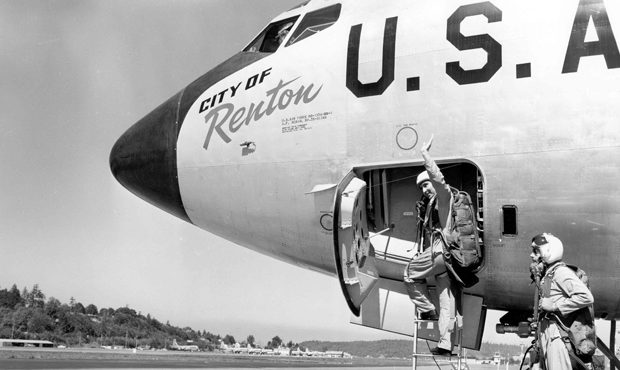
31 August 1956: The first production Boeing KC-135A Stratotanker, 55-3118, named City of Renton, made its first flight with company test pilots Alvin Melvin (“Tex”) Johnston and Richards Llewellyn (“Dix”) Loesch, Jr., on the flight deck.
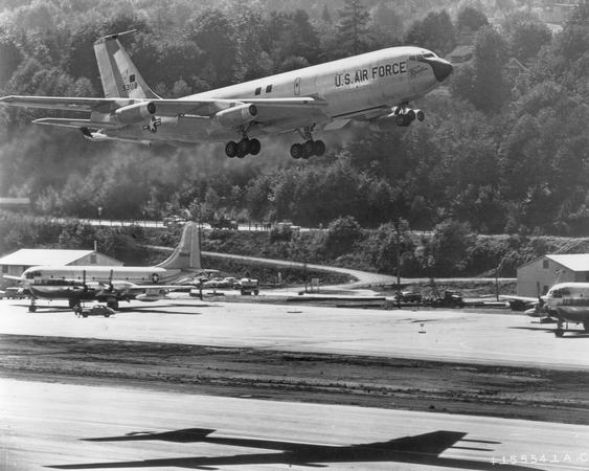
Built as an aerial refueling tanker to support the U.S. Air Force fleet of B-52 strategic bombers, an initial order for 29 tankers was soon followed by three additional orders, bringing the total to 275 airplanes by the end of Fiscal Year 1958.¹ Eventually 732 KC-135As were built by Boeing, and an additional 81 of other versions.
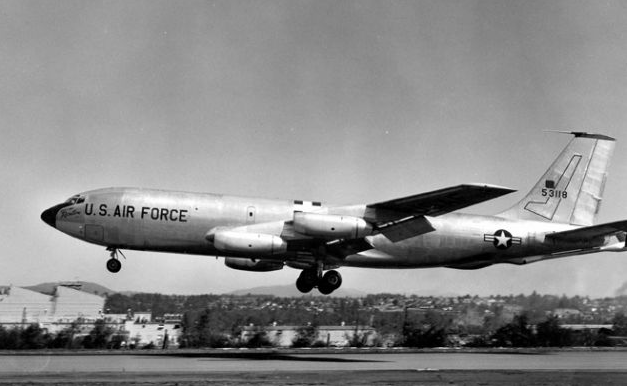
With the company internal designation of Model 717, the KC-135 was developed from the Model 367-80 proof-of-concept prototype, the “Dash Eighty.” The Stratotanker is very similar in appearance to the Model 707 and 720 airliners but is structurally a different aircraft. It is also shorter than the 707 and has a smaller diameter fuselage.
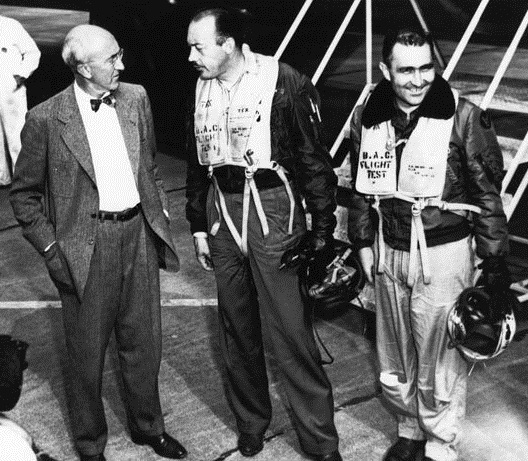
The Stratotanker was originally operated by a flight crew of four: pilot, co-pilot, navigator, and refueling boom operator. Upgrades over the decades have simplified operation and the crew has been reduced to two pilots and the boom operator. The tanker’s maximum transfer fuel load is 200,000 pounds (90,719 kilograms). The KC-135 can carry 83,000 pounds (37,648 kilograms) of cargo, and up to 37 passengers.It can also be configured to carry cargo or up to 32 passengers.
The KC-135A is 136 feet, 3 inches (41.529 meters) long, with a wingspan of 130 feet, 10 inches (39.878 meters) and overall height of 41 feet, 8 inches (12.700 meters). The Stratotanker’s maximum takeoff weight is 322,500 pounds (146,284 kilograms).
The KC-135A was powered by four Pratt & Whitney J57-P-59W turbojet engines. The J57 was a two-spool, axial-flow engine with a 16-stage compressor section (9 low- and 7-high-pressure stages) and a 3-stage turbine section (1 high- and 2 low-pressure stages). These engines were rated at 13,750 pounds of thrust (61.16 kilonewtons), each. The J57-P-59W was 183.5 inches (4.661 meters) long, 38.9 inches (0.988 meters) long and weighed 4,320 pounds (1,920 kilograms).
The Stratotanker fleet has been re-engined with more efficient CFM International CFM56 turbofan engines which produce 21,634 pounds of thrust (96.23 kilonewtons), each. The upgraded aircraft are designated KC-135R.
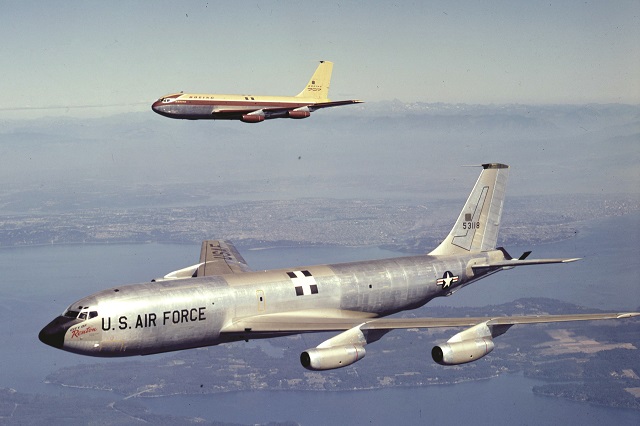
The tanker has a cruise speed of 530 miles per hour (853 kilometers per hour) at 30,000 feet (9,144 meters). The service ceiling was 50,000 feet (15,240 meters). Its range is 1,500 miles (2,414 kilometers) when carrying 150,000 pounds (68,039 kilograms) of transfer fuel, and the maximum ferry range is 11,015 miles (17,727 kilometers).
Of the 803 KC-135 aircraft built, 396 remain in service with the U.S. Air Force (as of 14 May 2018). It is estimated that the fleet is 33% through their design lifetime limits.
The first production airplane, 55-3118, was used for flight testing. It was later modified into an EC-135K Head Dancer airborne command post. Today, the first Stratotanker is on display at the front gate of McConnell Air Force Base, Kansas.
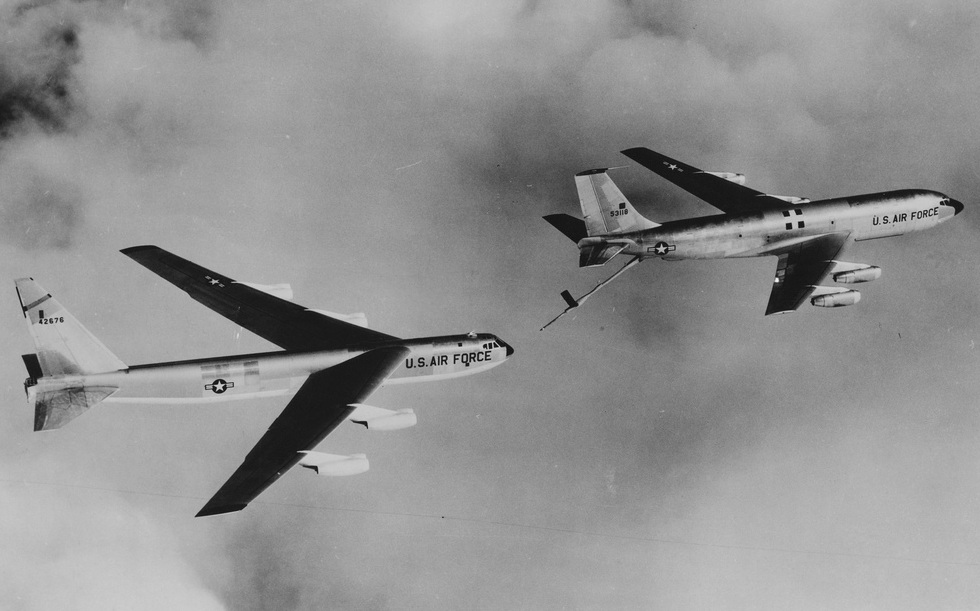
¹ KC-135A-BN: 57-1418–57-1514; 57-2589–57-2609; 58-0001–58-0130; total: 275
© 2018, Bryan R. Swopes
Just a few errors in your story.
“Built as an aerial refueling tanker to support the U.S. Air Force fleet of B-52 strategic bombers, an initial order for 24 tankers was soon increased to 250. ”
The initial order was for 29 KC-135s, followed by an additional order for 250 more.
“The Stratotanker was originally operated by a flight crew of five: pilot, co-pilot, navigator, flight engineer and refueling boom operator.”
There was never a Flight Engineer crew position on the KC-135.
“The tanker has a maximum speed of 580 miles per hour ”
The KC-135A/E/Q all had a max airspeed exceeding 600 MPH or over 500 KIAS, or .95 Mach.
“The first production airplane, 55-3118, was delivered to an operational squadron at Castle Air Force Base in June 1957.”
KC-135A # 55-3118 spent almost 6 years as a flight test airplane. The KC-135 flight testing airplanes were the first 9 off the production line, #s 55-3118 thru 22-3126. The first operational KC-135 delivered to the 93rd Air Refueling Squadron at Castle AFB, CA was #55-3127 in June 1957.
“Boeing KC-135A-BN Stratotanker 55-3118, City of Renton, refuels B-52C-50-BO Stratofortress 54-2676. (U.S. Air Force)”
This particular B-52C, # 54-2676 was a flight test airplane for the coming B-52D and B-52E models. She flew with Boeing from late 1954 to about 1957 when she was turned over to SAC (notice she has no wing crest, or SAC “milkyway” on the nose). It originally did not have a Gunner’s position in the tail, a bomb-nav system, 3000 gallon wingtip drop tanks (standard on the B-52C thru B-52F), or electronic warfare suit.
A little bit of trivia. The first KC-135A (55-3118) was rolled out and parked next to the last KC-97G that rolled out, tail # 53-3824. Another bit of trivia is that the contract for the USAF’s first jet tanker (1955 KCX program) was not suppose to go to Boeing. It was Lockheed’s “turn” as Boeing had the C/KC-97 and Douglas had the C-124 contracts (yes, Lockheed was at the time producing the C-130 which began in 1953). The Lockheed tanker was to be based on their proposed L-193 airliner/tanker. It was a 4 engine (fuselage mounted between the wing and the tail) that was about 18′ shorter fuselage and a 26′ shorter wingspan than the KC-135. If it had entered USAF service it would have been designated the K-1A (it did not have a cargo or passenger capability) and the XK-1 for the prototypes. It was smaller, slower, lower fuel capacity, no troop or cargo capability, and did have a 5 man crew when compared to the 4 man crew KC-135A, and costs about the same per unit. The USAF ended up not ordering the K-1A, and airline orders for the L-193 dried up, too.
My mistake,. the airspeed should read in excess of 550 KTAS, not KIAS. The KC-135A had a “barber pole” limit of 355 KIAS.
Looks like I’ve got some re-writing to do. Thanks for the information.
Thanks for the rich article. It is staggering to consider the effect the aircraft has had on strategic deterrence and its constant use supporting extremely long-range tactical strikes over the past 32 years. I always love the selection of photos you employ in your “Tales of the Sky”! Have a great Labor Day Weekend.
Thanks, Tom. I’m glad you liked the article.
I hope they have a jet flyover at tomorrow’s NHRA Indy Nationals. Love to see two F-15’s light their burners as they fly low over the grounds! Now that is Big Horsepower even beyond a Funny Car at half-track.
Wasn’t it 1956?
Yes, you are correct. I have fixed the mistake.
Bryan,
While you are editing this excellent article,
the correct date is 31 August 1956.
??
ℭhief ℬob
?️ Scatback ✍ Scribe
Citation:
https://www.af.mil/About-Us/Fact-Sheets/Display/Article/1529736/kc-135-stratotanker/
Oooops… I must fallen asleep at the keyboard. Thanks, Bob. I appreciate the catch. —Bryan
Can it refuel itself?
Sam, no, it can’t.
Hey Brian, good stuff but a few clarifications are in order:
You mention that 732 tankers were made plus an additional 81 aircraft of other versions. This adds up to a total of 813. The math is off somehow because the total production was 820 airframes as follows:
KC-135A 732
C-135A 15
C-135B 30
C-135F 12
KC-135B 17
RC-135A 4
RC-135B 10
Also, you state that the KC-135 is shorter than a 707. It may be shorter than most 707s, but the 707-138 specially made for Qantas had the exact same fuselage length, 128’ 10”, as the KC-135, so body length is not a discriminator between the 707 and the KC-135. (note that overall lengths differ because the KC-135’s boom adds to the overall length, otherwise a 707’s stabilizers extend beyond the aft end of the fuselage giving an overall length longer than the fuselage length, but the body lengths of a 707-138 and a KC-135 are absolutely identical.)
Thanks!
Brian, I just liked the old pictures of Renton. Thanks for taking all the “gentle corrections” so well!
a Boom Operator once told me that he was the only Airforce Member earning his pay on his belly ?
55-3118 spent most of its flying time as a EC-135K
55-3118 spent most of its flying time as a EC-135K
The crew consisted of pilot ,copilot,navigator,3 flt mechs,3 radio operators and 1 flt attendant
Those 4 RC135As were likely the ones attached to ACGS at Keesler and Forbes. I worked on them at Forbes and AST10 in Brazil.
Thank you for this aviation history! My father was one of the original SR-71 pilots when the first squadron was formed at Beale AFB, CA in the early 1960s. The refuelers were vital to that program! I posted your article on our FB Habubrats page. I’m sure the kids of these guys will enjoy reading about it.
Thank you, Lori.
I live near Mildenhall, Suffolk, in England. Still get an almost daily buzz from watching them pass overhead. Now being gradually phased out, I’m gonna miss them when they’re gone. Thanks for the sights and sounds. ?
just leaving my two cents worth. The WC 135 and OC 135 flew with Flight Engineers. 55th WRS out of McClellen CA and the 45 RECON at Offutt also the 8th ACCS out of Tinker plus a couple others.
Gosh, looks as tho Tex is having ‘words’ with Bill Allen after the flight.
Maybe Bill mentioned he was glad he didn’t try to roll it 😂